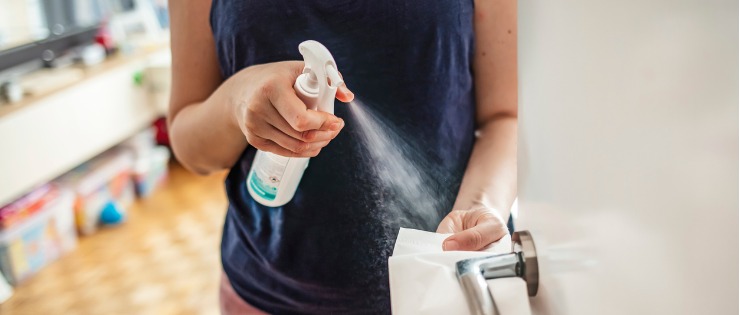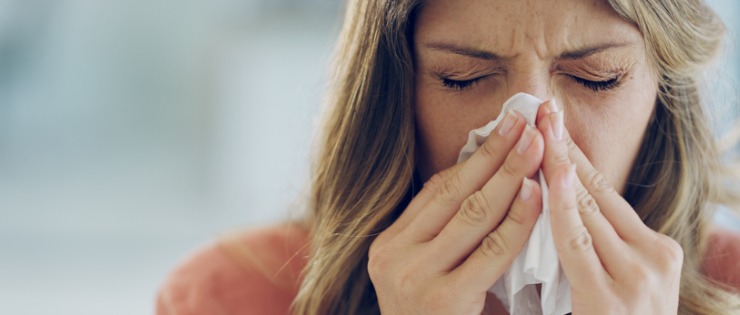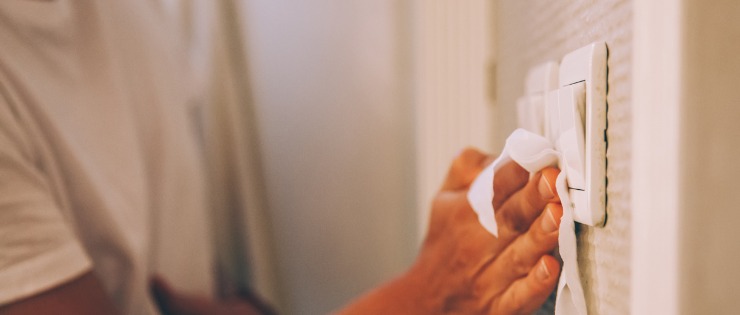
Whether winter is your favourite season or not, most of us dread the common cold and flu infections that come with it.
Most of the time, keeping our homes clean using basic cleaners and microfibre cloths are fine. However, winter calls for a disinfectant to kill bacteria and germs that can cause illness. Find out how you can rid your home of the flu virus this year and stay healthy.
What is the Flu?
The flu virus is classified into Types A, B and C. Types A and B circulate and cause seasonal flu epidemics.
Around 5-10% of the global adult population contracts the flu annually while 20-30% of children suffer according to the World Health Organisation (WHO). Most people recover with bed rest within a week or two but some need hospital treatment to recover from the respiratory illness.

According to the Centers for Disease Control and Prevention (CDC) and the Australian Department of Health , flu symptoms include fever, cough, sore throat, muscle aches, headaches, runny or stuffy nose, fatigue and, sometimes, vomiting and diarrhea.
In Australia, a typical flu season results in 18,000 hospitalisations and on average 1,500 to 3,000 deaths. People who are elderly or suffer from a chronic disease are more at risk of dying from the influenza virus. Annual vaccinations are the best defence against catching the flu.
How Is the Flu Spread?
The flu is an infectious disease which spreads when a sick person coughs, sneezes or even talks. Their respiratory droplets land on the nose or mouth of new victims or are breathed in. Contaminated surfaces are another source of infection. The flu virus can live on some surfaces for up to 24 hours so if someone touches the virus then their face, they can become infected.
Flu symptoms begin one to four days after the virus enters the body. Good hygiene practices such as regular hand washing, coughing and sneezing into your elbow and disposing used tissues in the bin can help stop the spread.
What To Do If Someone in the House Has the Flu
While someone with the flu is contagious, take action to reduce the chance of it spreading to other members of the household. If you have the flu, stay home! Don't go into work or other places where you can spread the infection.
Isolation
If a member of your household thinks they have the flu, it’s best they isolate themselves in one room away from the rest of the household. Ideally, they should have access to a bathroom that only they use. Isolation means there's less risk of another member catching the flu because there are fewer airborne flu virus particles and on surfaces in the rest of the house. There are also fewer surfaces to keep clean!
According to the CDC, people with the flu are most contagious in the three to four days after the illness begins, but children and some adults are thought to be contagious for a longer period so isolation should continue for most of the week.
Cleaning To Fight the Flu
Cleaning the home during and after a flu infection reduces the risk of spreading the virus to other household members.
Respiratory droplets containing the flu virus can land on surfaces so it’s important to disinfect benchtops and tabletops regularly. Other often touched surfaces such as door knobs, light switches, taps, toilet buttons, alarm keypads, kettle handles, remotes, computer keyboards and the stair rail should be cleaned daily if someone in the house is suffering from the flu. It’s possible to bring home the flu virus on your hands so always wash with soap and water as soon as you return home.

If bedding is being shared, wash it more often on a hot cycle to kill the germs. Wash your hands with soap for 20 seconds after handling dirty laundry. Keep the towel and toothbrush of a sick family member well away from other members’. Wash their cutlery in hot soapy water or in the dishwasher to kill the virus.
What Cleaning Products to Use
Looking at the supermarket shelves it’s hard to know which cleaning products will keep you safe from the flu virus and which ones are only a little more effective than water.
Commercial Cleaners
It’s important to understand the difference between cleaning and disinfecting. Some products will remove grime but won’t kill bacteria. If a product label says it can kill 99.9% of bacteria then it’s suitable against the flu virus. Read the instructions to ensure you are leaving the solution on the surface long enough to work before wiping away. To effectively kill bacteria some products need to be left on a hard surface for one minute while others need three or more minutes to work according to microbiologist and author Jason Tetro.

Clean & Green
Over the last 10 years, many Australians have stopped using supermarket-bought cleaners to reduce the number of chemicals in their home and switched to products our grandmothers would have used.
Vinegar has grown in popularity because it’s a cheap, biodegradable and non-toxic disinfectant that has been used for thousands of years. US researchers found neat vinegar kills a range of household pathogens including the flu virus. They discovered that vinegar was only slightly less effective than some commercial cleaners at killing all bacteria. Only two commercial cleaners were effective against the tough poliovirus. Another study found that vinegar destroyed tuberculosis, a hard to kill bacteria, proving its effectiveness.
Steam can also kill germs, bacteria and dust mites. A steam cleaner is ideal for killing the flu virus on curtains and other products that may be difficult to wash regularly.
Microfibre Cloths
Microfibre cloths don’t kill bacteria and viruses like liquid disinfectants do, the fine fibres remove them from surfaces. Cleaning the cloths in a washing machine with detergent kills the bacteria and viruses. People who are sensitive to chemical cleaners or want to reduce the number of chemicals in their home and the environment often choose microfibre cloths.
Gloves
Wearing gloves while you clean won’t stop you from spreading bacteria around the house, but they keep your hands clean. You'll also be possibly less likely to touch your nose or mouth while wearing gloves which is what the flu virus needs to enter your body.
Stopping the Spread of the Flu Virus at Home
When a person in your home contracts the flu, you need to take action to prevent other members of the household contracting it.
But when it comes to ridding germs from our home that can make you sick, do we know what we’re doing? It might surprise you to learn that your quick swipe of the benchtops and vacuum isn’t protecting your family from the flu and other illnesses. Understanding how and what we should clean can help us win the battle against unseen enemies.
How do you keep your home sterile?
While no house is germ-free, regular cleaning and disinfecting of often touched surfaces such as door knobs, light switches, benches and tabletops will reduce the number of germs.

A microbiologist’s recommendations include washing your bath towel after every three uses, washing bed linen once a week, disinfecting the kitchen sponge after every use, cleaning the remote weekly and your mobile phone every two days and always following good hand washing hygiene.
To sterilise an area of your home, first, clean off any grime and loose dirt using an all-purpose cleaner. It’s impossible to disinfect a surface if it hasn’t been cleaned first. You can then treat the area with a disinfectant as the second step.
Look for the word ‘disinfectant’ on the label or check the ingredients of your cleaner to see if it’s a disinfectant. Disinfectant ingredients include chlorine, hypochlorite, hydrogen peroxide, iodine-based antiseptics, alcohols, peroxygen compounds, and detergents. Read the instructions to ensure you’re using it effectively.
How do I know what I should clean and when?
Some areas of your house need more regular cleaning than others. The kitchen is a bacteria hotspot and needs daily cleaning. But it’s not just the dirt we can see that is cause for concern. The dust that settles on the top of bedroom ceiling fans, on curtains and under beds can harbour nasty bacteria and impact on the quality of the air you’re breathing.
The Australian Department of Health has a list of cleaning tasks and how often they should be tackled to keep your home clean.
Does airing out your house help with germs?
In winter we’re more likely to keep the doors and windows closed to stop the cold air coming in, but airing the house lets the stale air out and fresh air in. Airing out the house increases airflow making it less likely we’ll breathe in germs. Studies have proved that ventilation reduces the risk of disease transmission.

How do you kill bacteria in your house?
Remember cleaning removes dirt and grime but to kill bacteria and microorganisms, you need to correctly use a disinfectant. Read the instructions on the disinfectant to find out what the dwell time of the product is before you wipe the product off. The liquid needs time to search and kill bacteria.
Does opening windows help with germs?
Opening the windows improves airflow which makes it more difficult for bacteria and viruses to multiply. Indoor air quality can be far worse than outdoor air quality so opening the windows can improve it. The American College of Allergists states that 50 percent of all illnesses are caused by polluted indoor air.
Why We Need to Avoid the Flu More Than Ever
More than ever it’s important to keep the house free of germs to protect us from the common cold, flu and COVID-19 viruses. With Australians spending more time at home and social distancing this winter, it’s hoped the flu virus won’t spread as widely as previous flu seasons.
All Australians are recommended to have the flu vaccine this winter. While the vaccine doesn’t provide any protection against contracting COVID-19, it’s the best protection against contracting the flu. You want to avoid getting both viruses simultaneously because it could make you very ill according to the Department of Health.